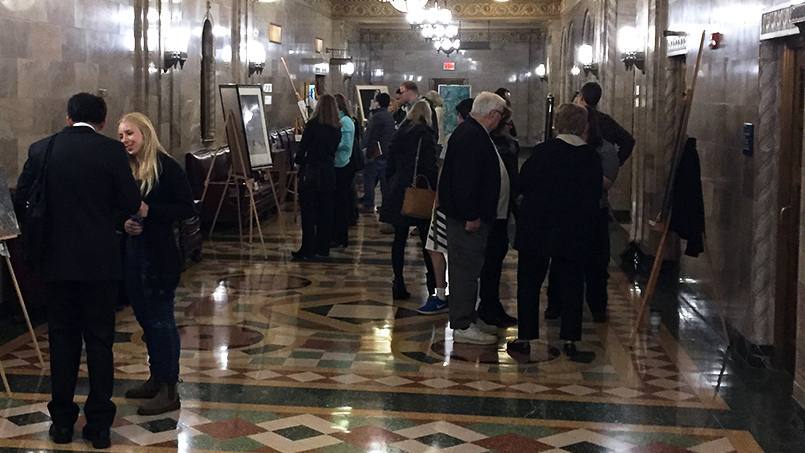This story originally appeared on the In the Loop blog.

The first Mayo Clinic Sleep and Stroke Conference included a unique element: an art exhibit designed to encourage new ways of thinking.
Margaret Grill's dreams have a recurring theme. "I regularly have dreams where I need to complete a task, but my body will refuse to move," says Grill, an artist. She tells us she tried to capture the feeling of that dream in her painting, "Nebuchadnezzar," "by portraying a series of legs in a static state." The work — a mix of drawing, collage and water-soluble oils — is finished with a layer of copper leaf, which Grill says reminds her "of the story of Nebuchadnezzar and his dream of legs made of bronze, iron and clay."
Grill's "Nebuchadnezzar" was among 21 works that recently found themselves in an unexpected venue. They were featured in a unique art show that closed out the first Mayo Clinic Sleep and Stroke Conference. "Art is a powerful way to share what one person 'sees' with another," says Timothy Morgenthaler, M.D.
Dr. Morgenthaler, a Mayo sleep medicine specialist who co-chaired the conference, conceived the art show as a way to help inspire new connections and conversations among those attending.
The resulting conversations were "fascinating," says Dr. Morgenthaler. "Many of the artists explained how they tried to capture either a recurring dream of theirs or just to capture how they experienced dreams in general," he says. "The attendees then tried to compare the artist's experience with what they know about what science says is going on during sleep.""Taking time to communicate with one another about sleep in a visual way with creative people I thought might bring a new perspective for the clinical scientists," he tells us. He also hoped "the opposite would be true — that the artists would get more in touch with sleep science as it might apply to their lives." So after a full day of scientific presentations, conference participants adjourned to the Plummer Building, where Grill and 10 other Minnesota artists displayed their work. The art captured "dreaming and brain function in a way words cannot express," says Melissa Lipford, M.D., a neurologist and conference co-chair.
Grill says it was special to have scientists "give their impressions of my work." For the scientists, the conversations were "invigorating," Dr. Lipford tells us. After the exhibit "there were multiple additional discussions about future projects and plans well into the evening." The art also served as a way to "connect to the humanistic side of medicine," she says. "The works connected me to the patient experience and served as a reminder of why each of us dedicates ourselves to this line of work."
Jesse Welsh, an education program manager in Provider Relations who recruited the artists for the exhibit, says the event earned rave reviews. Attendees appreciated "being able to use a different part of their brain," she says, and artists felt "honored" to be invited to "share their work in such a different context. This opened up Mayo to the community in a way it hadn't been before."
Participating artists included: Lexi Ames, Michaela Chorn, Margaret Grill, Bianca Jarvis, Susan Kassin, Bethany Kelley, Mary Klein, Steph Kunze, Laura Anne White, Maura Williams and Jane Wunrow.
______________________________________________







